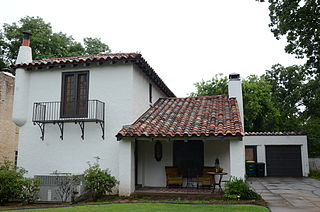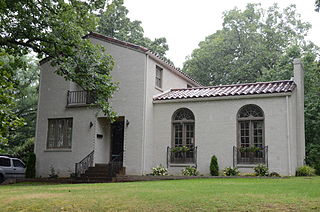Frank Carmean was an architect in Arkansas. Not formally trained as an architect, but rather experienced in building construction, he became a designer. He joined a firm in 1927 that was developing the Edgemont residential area of Little Rock, and is believed to have designed all but one of the 16 homes in the development. The firm billed him as their "architect", and he toured to collect new designs. He introduced or expanded the use of Spanish Colonial architecture in Little Rock.

The Gazette Building in Little Rock, Arkansas was built in 1908. It was designed by architect George R. Mann, and built by Peter Hotze. The building was listed on the U.S. National Register of Historic Places in 1976. Originally and for many years, the building served as the headquarters of the Arkansas Gazette newspaper. Its historic building in downtown Little Rock served as the national campaign headquarters for the 1992 presidential campaign of Governor Bill Clinton. It now houses the Elementary and Middle Schools for eStem Public Charter Schools.

T. R. Pugh Memorial Park is a re-creation of an 1880s era water-powered grist mill located in North Little Rock, Arkansas. It was used in the opening scenes of the movie classic Gone With The Wind. In 2010, the site was listed on the National Register of Historic Places.

The Duffy House is a historic house at 124 East "A" Street in North Little Rock, Arkansas. It is a two-story stuccoed structure with a tile roof in the Spanish Colonial style, with a single-story addition to the west, and a garage to the southwest, with a small attached maid's quarters. The house was built in 1929 by Justin Stewart as part of a large subdivision. Due to the effects of the Great Depression, it remained unsold for several years, and typifies the houses built in the subdivision before the 1929 stock market crash.

The Edgemere Street Bridge is a historic bridge in North Little Rock, Arkansas. It carries Edgemere Street over a small part of Lakewood Lake Number Three. It is a masonry structure with closed spandrels, and has a span of about 18 feet (5.5 m) and a total length of 57 feet (17 m). It is built out of rustic, roughly squared fieldstone, that is laid in uncoursed fashion. Vertical columns project from either side of the spandrels, rising above the deck level to form a decorative parapet. It was built, along with the similar Lakeshore Drive Bridge as part of the innovative Lakewood Development project of developer Justin Matthews in the 1930s.

The Joseph E. England Jr. House is a historic house at 313 Skyline Drive in North Little Rock, Arkansas. It is a 1-1/2 story brick and stone structure, set on a wedge-shaped lot with expansive views of the Arkansas River. Built in 1928, it is a fine example of Tudor Revival architecture, and one of the Edgemont neighborhood's most elaborate pre-Depression houses. It was built for a prominent local banker and businessman who was an associated of Edgemont's developer, Justin Matthews.

The Jeffries House is a historic house at 415 Skyline Drive in North Little Rock, Arkansas. It is a 2-1/2 story wood frame structure, finished in a fieldstone veneer, and is three bays wide, with a side gable roof, end chimneys, and symmetrical single-story wings at the sides. The house is distinctive as a fine example of Colonial Revival architecture, rendered in the unusual veneered stone finish. Built in 1931 by the Justin Matthews Company, it was the last house Matthews built in the Edgemont subdivision before the Great Depression brought the development to an end.

The Green House is a historic house at 1224 West 21st Street in Little Rock, Arkansas. It is a single-story wood frame structure, with front-facing gable roof and weatherboard siding. A section with a smaller gable projects forward, and the main entrance on the left side, under a projecting gable. All gables have exposed rafter ends in the Craftsman style. It was built in 1916, and was from the 1930s home to the Ernest Green family, whose son Ernest, Jr. was the first African-American student to graduate from Little Rock Central High School.

The Matthews-Storey House is a historic house at 8115 Ascension Road in southern Little Rock, Arkansas. It is a mostly single-story Craftsman Airplane-style structure, in which a small second story at the center makes the building resemble an early aircraft. The building features a carport to the right and a projecting porch to the front, each with supporting stone pillars and exposed rafters underneath. The house was built in 1925 by the Justin Matthews Company, a major developer in the city at that time.

The Lakeshore Drive Bridge carries a closed-off portion of Lakeshore Drive across a tributary stream on the west side of Lake Number 3 in North Little Rock, Arkansas. It is a stone arch bridge with closed spandrels and a total structure length of 53 feet (16 m). The bridge consists of a single elliptical curved arch, which spans 20 feet (6.1 m) and is 5 feet (1.5 m) high. Rustic square stone columns rise from the spandrels, creating uneven parapets on the sides of the structure. The bridge was built in the late 1930s as part of developer Justin Matthews' construction of the Lakewood area. It is one of a small number of documented masonry arch bridges in the state.

The Matthews House is a historic house at 406 Goshen Street in North Little Rock, Arkansas. Built in 1928, it is an unusually modern interpretation of Georgian Revival architecture, designed by Frank Carmean and built by Justin Matthews as a showcase home for his Park Hill development. It has a stuccoed exterior, and its shape is that of squares intersecting at a circular stairwell. Its interior exhibits elements of Art Deco styling. The house was widely advertised by Matthews after its completion, and more than 20,000 people are estimated to have toured it.

The Matthews-Bradshaw House is a historic house at 524 Skyline Drive in North Little Rock, Arkansas. It is a single-story masonry structure, its exterior clad in brick and stone. A conical turreted section with diamond-pane windows projects from one corner, and the gable above the main entrance is finished in half-timbered stucco. Built in 1929 by the Justin Matthews Company as part of its Park Hill development, it is the only example Matthews built of the French Eclectic style. It was designed by Frank Carmean, the Matthews Company architect.

The Matthews-Bryan House is a historic house at 320 Dooley Road, North Little Rock, Arkansas. It is a single-story masonry structure, built in the English Revival style in 1930 by the Justin Matthews Corporation as part of its Park Hill development. It has a steeply pitched gable roof, with cross-gabled entrance, and is faced in stone and brick. It was designed by Matthews Company architect Frank Carmean, and was one the last houses built by Matthews before the full effects of the Great Depression affected his building style.

The Matthews-Dillon House is a historic house at 701 Skyline Drive in North Little Rock, Arkansas. It is a 2-1/2 story brick building, with a steeply pitched gable roof in a saltbox profile. The roof is continued over a small front porch, with flush-set chimneys to its left and a gabled projection to its right. The house was built in 1928 by the Justin Matthews Company, to a design by company architect Frank Carmean. The house is locally unusual for its evocation of colonial New England architectural style, executed as a brick variant of medieval English architecture.

The Matthews-Godt House is a historic house on the 248 Skyline Drive in North Little Rock, Arkansas. Built in 1928, it is an unusual and early example of a split-level house, a style that did not become popular until the 1950s. It is a frame structure finished in brick veener, in the English Revival style. It was built by developer Justin Matthews as part of his Edgemont development, and was designed by his company architect, Frank Carmean.

The Matthews-MacFayden House is a historic house at 206 Dooley Road in North Little Rock, Arkansas. It is a two-story brick structure, with gable-on-hip roof, and a projecting single-story gable-roofed section on the right side of the front. Decoratively corbelled brick chimneys rise at the center of the main roof, and a projecting wood-framed oriel window adds a distinctive touch to the front. The house was built in 1930 by developer Justin Matthews as part of his Edgemont development, and was designed by his company architect, Frank Carmean. It is a picturesque example of English Revival architecture.

The Owings House is a historic house at 563 Skyline Drive in North Little Rock, Arkansas. It is a two-story brick building, with classic Spanish Revival features, including a tile roof, arched openings, and iron grillwork. It is unusual in that its brick has not been stuccoed. The house was built in 1927 by Justin Matthews as part of his large Edgemont development. It was the first house to be completed, and was lost by its owners to foreclosure during the Great Depression.

The Park Hill Historic District encompasses the first suburban residential subdivision of the city of North Little Rock, Arkansas. It covers 172 acres (70 ha) in a geographically central part of the city, bisected by JFK Boulevard, and roughly bounded on the north by H Avenue, the west by Ridge Road, the east by Cedar Street and Plainview Circle, and the south by Crestview Drive. This area was developed beginning in 1922 by Justin Matthews, a major local developer, and greatly expanded the city's housing stock through the 1940s and 1950s. The vast majority of its architecture is residential, with commercial development limited to its major arterial roadways. The district includes Crestview Park and the Park Hill Fire Station and Water Company Complex.

The Waterside Street Bridge is a historic bridge, carrying Waterside Street across an inlet of Lake Number 1 in North Little Rock, Arkansas. It is a rustic closed-spandrel masonry structure, with an exterior of rough uncoursed fieldstone that rises to parapet above the side of the roadbed. It is one of four masonry bridges built between 1929 and 1939 by developer Justin Matthews as part of the Lakewood subdivision.
























